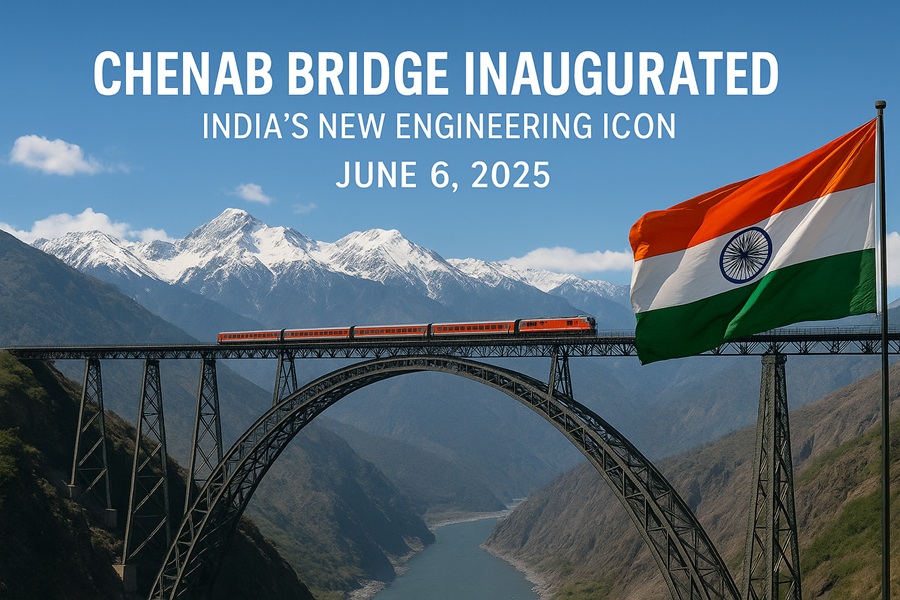In a historic moment for Indian infrastructure and regional development, Prime Minister Narendra Modi on Friday inaugurated the iconic Chenab Rail Bridge, the world’s tallest railway arch bridge, during his visit to Jammu and Kashmir. This engineering marvel, now operational, stands as a critical link in the Indian Railways' ambitious Udhampur-Srinagar-Baramulla Rail Link (USBRL) project, and it is being hailed as a transformative step for the region's economic and social integration with the rest of the country.
Chenab Bridge: Engineering Wonder of the World
The Chenab Bridge stretches 1,315 meters across the deep gorge of the Chenab River in the Reasi district of Jammu and Kashmir and soars to a staggering height of 359 meters (1,178 feet) above the riverbed—making it taller than the Eiffel Tower.
Constructed by Konkan Railway Corporation Limited (KRCL) in collaboration with Afcons Infrastructure and DRDO (Defence Research and Development Organisation), the bridge has been built using corrosion-resistant steel and is designed to withstand earthquakes, high-intensity winds (up to 260 km/h), and blasts, making it both structurally robust and secure.
It took over two decades of planning, testing, and construction to complete the bridge, with engineers having to overcome challenges posed by the treacherous Himalayan terrain, extreme weather conditions, and security concerns in the volatile region.
A New Era of Connectivity for Jammu & Kashmir
The inauguration of the Chenab Bridge symbolizes more than just architectural accomplishment—it marks a significant step in strengthening the physical and emotional connectivity of Jammu & Kashmir with the Indian mainland.
PM Modi emphasized this during his speech at the inauguration ceremony, stating:
“The Chenab Bridge is a symbol of New India’s determination. It is not just a bridge—it is a lifeline of development, bringing prosperity, tourism, and opportunity to our brothers and sisters in Jammu and Kashmir.”
Once fully operational, the USBRL project—of which the Chenab Bridge is a pivotal part—will enable direct rail connectivity between Kashmir Valley and the rest of India for the first time since independence. Currently, access to Kashmir is mainly via road or air, both of which are often hindered by snow, landslides, or political tensions. A year-round, all-weather rail service is expected to be a game-changer.
Benefits for Local People and Economy
For the local population, especially in the remote districts of Reasi, Ramban, and Baramulla, the bridge and the broader railway link promise a transformative impact:
Faster Travel and Logistics: Goods from the Kashmir Valley—especially perishable produce like apples, walnuts, saffron, and handicrafts—can now reach markets in Delhi, Mumbai, and even abroad more quickly and cheaply.
Boost to Tourism: With increased accessibility, domestic and international tourists are expected to flock to scenic locations like Gulmarg, Pahalgam, and Sonamarg, providing a much-needed boost to the hospitality and handicraft industries.
Employment Opportunities: Construction of the bridge itself generated thousands of jobs locally. Going forward, railway stations, logistics hubs, and related services are expected to create permanent employment in the region.
Access to Services: Easier mobility will facilitate better access to healthcare, education, and government services—especially vital in areas that were previously cut off for weeks during winter.
Geopolitical and Strategic Significance
For a region that has witnessed decades of conflict and insurgency, the Chenab Bridge sends a strong political and strategic signal. The Indian government sees infrastructure development as a key strategy in stabilizing the region and integrating it more closely into the national fold.
From a security standpoint, the rail link also facilitates faster movement of troops and equipment to forward areas along the Line of Control (LoC), thereby enhancing strategic preparedness in a region with persistent border tensions.
International Interest and Inspiration
The project has already attracted global attention. Engineering experts from Europe and the U.S. have studied the Chenab Bridge as a case of innovation under extreme conditions. Its completion showcases India’s growing competence in mega infrastructure development, setting a benchmark for developing countries around the world.
Infrastructure analysts from the European Investment Bank and World Bank have highlighted the project in recent reports as a model of integrating sustainability, resilience, and economic upliftment.
The Road Ahead
PM Modi’s visit to Jammu and Kashmir underscores the government’s continued focus on infrastructure as a means of peace-building and development. In addition to the bridge, the Prime Minister also announced several projects related to tourism development, hydropower, and youth entrepreneurship—with a clear emphasis on "Vikas aur Vishwas" (development and trust).
As trains begin to cross the Chenab Bridge, what was once a dream is now a steel reality—binding mountains, people, and opportunities together.
